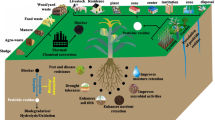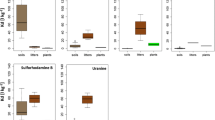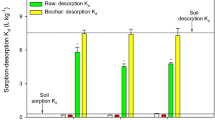Abstract
Mitigation of pesticide dispersion in soil and water is required to protect ecosystem health and the anthropic uses of water bodies. Biochar amendments have been suggested to reduce pesticide dispersion due to their high sorption potentials. Nevertheless, appraisals at different scales have been limited by the costs of pesticide analyses. The aim of this study was to evaluate the potential of two fluorescent tracers, uranine (UR) and sulforhodamine B (SRB), for use as pesticide proxies in the context of biochar amendments used for mitigation purposes. Therefore, we compared the sorption processes of both fluorescent tracers and those of three pesticides, glyphosate, 2,4-D, and difenoconazole for soils; three wood biochars (pine, oak, and beech/charm blend); and soil/biochar mixtures representing agricultural usages. The results showed that the sorption of glyphosate by soil was unaffected by amendment with the tested pine, oak, and wood blend biochars. In contrast, the sorption coefficients of UR, SRB, 2,4-D, and difenoconazole were significantly increased with these biochar amendments. SRB, in particular, exhibited sorption behavior similar to that of the hydrophobic fungicide difenoconazole. This indicates promise for the use of SRB as a proxy for hydrophobic pesticides, in testing biochar amendments.


Similar content being viewed by others
Data availability
The datasets used and/or analyzed during the current study are available from the corresponding author on reasonable request.
References
Bhatnagar A, Hogland W, Marques M, Sillanpää M (2013) An overview of the modification methods of activated carbon for its water treatment applications. Chem Eng J 219:499–511. https://doi.org/10.1016/j.cej.2012.12.038
Bork M, Lange J, Graf-Rosenfellner M, Lang F (2020) Controls of fluorescent tracer retention by soils and sediments. Hydrol Earth Syst Sci 24:977–989. https://doi.org/10.5194/hess-24-977-2020
Briceño G, Palma G, Durán N (2007) Influence of organic amendment on the biodegradation and movement of pesticides. Crit Rev Environ Sci Technol 37:233–271. https://doi.org/10.1080/10643380600987406
Cocozza C, D’Orazio V, Miano TM, Shotyk W (2003) Characterization of solid and aqueous phases of a peat bog profile using molecular fluorescence spectroscopy, ESR and FT-IR, and comparison with physical properties. Org Geochem 34:49–60. https://doi.org/10.1016/S0146-6380(02)00208-5
Cox RJ, Peterson HL, Young J, Cusik C, Espinoza EO (2000) The forensic analysis of soil organic by FTIR. Forensic Sci Int 108:107–116. https://doi.org/10.1016/S0379-0738(99)00203-0
Dai Y, Zhang N, Xing C, Cui Q, Sun Q (2019) The adsorption, regeneration and engineering applications of biochar for removal organic pollutants: a review. Chemosphere 223:12–27. https://doi.org/10.1016/j.chemosphere.2019.01.161
Ding Y, Liu Y, Liu S, Huang X, Li Z, Tan X, Zeng G, Zhou L (2017) Potential benefits of biochar in agricultural soils: a review. Pedosphere 27:645–661. https://doi.org/10.1016/S1002-0160(17)60375-8
Dissanayake Herath GA, Poh LS, Ng WJ (2019) Statistical optimization of glyphosate adsorption by biochar and activated carbon with response surface methodology. Chemosphere 227:533–540. https://doi.org/10.1016/j.chemosphere.2019.04.078
Dollinger J, Dagès C, Bailly J-S, Lagacherie P, Voltz M (2015a) Managing ditches for agroecological engineering of landscape A review. Agron Sustain Dev 35:999–1020. https://doi.org/10.1007/s13593-015-0301-6
Dollinger J, Dagès C, Voltz M (2015b) Glyphosate sorption to soils and sediments predicted by pedotransfer functions. Environ Chem Lett 13:293–307. https://doi.org/10.1007/s10311-015-0515-5
Dollinger J, Dagès C, Voltz M (2017) Using fluorescent dyes as proxies to study herbicide removal by sorption in buffer zones. Environ Sci Pollut Res 24:11752–11763. https://doi.org/10.1007/s11356-017-8703-4
Dosskey MG (2001) Toward quantifying water pollution abatement in response to installing buffers on crop land. Environ Manag 28:577–598. https://doi.org/10.1007/s002670010245
Dosskey MG, Vidon P, Gurwick NP, Allan CJ, Duval TP, Lowrance R (2010) The role of riparian vegetation in protecting and improving chemical water quality in streams1. JAWRA J Am Water Resour Assoc 46:261–277. https://doi.org/10.1111/j.1752-1688.2010.00419.x
Durst R, Imfeld G, Lange J (2013) Transport of pesticides and artificial tracers in vertical-flow lab-scale wetlands. Water Resour Res 49:554–564. https://doi.org/10.1002/wrcr.20080
Ellerbrock RH, Kaiser M (2005) Stability and composition of different soluble soil organic matter fractions–evidence from δ13C and FTIR signatures. Geoderma 128:28–37. https://doi.org/10.1016/j.geoderma.2004.12.025
Fernández-Pascual E, Zaman S, Bork M, Lang F, Lange J (2019) Long-term mesocosm experiments to investigate degradation of fluorescent tracers. J Hydrol X 2:100014. https://doi.org/10.1016/j.hydroa.2018.100014
Flury M, Wai NN (2003) Dyes as tracers for vadose zone hydrology. Rev Geophys 41. https://doi.org/10.1029/2001RG000109
Hall KE, Spokas KA, Gamiz B, Cox L, Papiernik SK, Koskinen WC (2018) Glyphosate sorption/desorption on biochars – interactions of physical and chemical processes. Pest Manag Sci 74:1206–1212. https://doi.org/10.1002/ps.4530
Houot S, Pons MN, Pradel M, Tibi A, Aubry C, Augusto L, Barbier R, Benoît P, Brugère H, Caillaud MA, Casellas M, Chatelet A, Dabert P, De Mareschal S, Doussan I, Etrillard C, Fuchs J, Génermont S, Giamberini L, Hélias A, Jardé E, Le Perchec S, Lupton S, Marron N, Ménasseri S, Mollier A, More C, Mougin C, Nguyen C, Parnaudeau V, Patureau D, Pourcher AM, Rychen G, Savini I, Smolders E, Topp E, Vieublé L, Viguié C (2014) Valorisation des matières fertilisantes d’origine résiduaire sur les sols à usage agricole ou forestier, impacts agronomiques, environnementaux, socio-économiques. (Expertise scientifique collective). INRA -CNRS -IRSTEA, France
IUSS Working Group WRB (2014) IUSS working group WRB world reference base for soil resources 2014 (No. 106) FAO, Rome, Italy
Khorram MS, Sarmah AK, Yu Y (2018) The effects of biochar properties on fomesafen adsorption-desorption capacity of biochar-amended soil. Water Air Soil Pollut 229:60. https://doi.org/10.1007/s11270-017-3603-2
Lange J, Schuetz T, Gregoire C, Elsässer D, Schulz R, Passeport E, Tournebize J (2011) Multi-tracer experiments to characterise contaminant mitigation capacities for different types of artificial wetlands. Int J Environ Anal Chem 91:768–785. https://doi.org/10.1080/03067319.2010.525635
Leenhardt S, Mamy L, Pesce S, Sanchez W, Achard AL, Amichot M, Artigas J, Aviron S, Barthélémy C, Beaudoin R, Bedos C, Bérard A, Berny P, Bertrand C, Bertrand C, Betoulle S, Bureau-Point E, Charles S, Chaumont A, Chauvel B, Coeurdassier M, Corio-Costet MF, Coutellec MA, Crouzet O, Doussan I, Faburé J, Fritsch C, Gallai N, Gonzalez P, Gouy V, Hedde M, Langlais A, Le Bellec F, Leboulanger C, Le Gall M, Le Perchec S, Margoum C, Martin-Laurent F, Mongruel R, Morin S, Mougin C, Munaron D, Nélieu S, Pelosi C, Rault M, Sabater S, Stachowski-Hberkorn S, Sucré E, Thomas M, Tournebize J (2022) Impacts des produits phytopharmaceutiques sur la biodiversité et les services écosystémiques, Synthèse du rapport d’ESCo, in: ESCO. France, p. 138
Lévesque V, Oelbermann M, Ziadi N (2022) Biochar in temperate soils: opportunities and challenges. Can J Soil Sci 102:1–26. https://doi.org/10.1139/cjss-2021-0047
Liu Y, Lonappan L, Brar SK, Yang S (2018) Impact of biochar amendment in agricultural soils on the sorption, desorption, and degradation of pesticides: a review. Sci Total Environ 645:60–70. https://doi.org/10.1016/j.scitotenv.2018.07.099
Maillard E, Lange J, Schreiber S, Dollinger J, Herbstritt B, Millet M, Imfeld G (2016) Dissipation of hydrological tracers and the herbicide S-metolachlor in batch and continuous-flow wetlands. Chemosphere 144:2489–2496. https://doi.org/10.1016/j.chemosphere.2015.11.027
Martin SM, Kookana RS, Van Zwieten L, Krull E (2012) Marked changes in herbicide sorption–desorption upon ageing of biochars in soil. J Hazard Mater 231–232:70–78. https://doi.org/10.1016/j.jhazmat.2012.06.040
Martinho VJPD (2019) Best management practices from agricultural economics: mitigating air, soil and water pollution. Sci Total Environ 688:346–360. https://doi.org/10.1016/j.scitotenv.2019.06.199
Molénat J, Raclot D, Zitouna R, Andrieux P, Coulouma G, Feurer D, Grunberger O, Lamachère JM, Bailly JS, Belotti JL, Ben Azzez K, Ben Mechlia N, Ben Younès Louati M, Biarnès A, Blanca Y, Carrière D, Chaabane H, Dagès C, Debabria A, Dubreuil A, Fabre JC, Fages D, Floure C, Garnier F, Geniez C, Gomez C, Hamdi R, Huttel O, Jacob F, Jenhaoui Z, Lagacherie P, Le Bissonnais Y, Louati R, Louchart X, Mekki I, Moussa R, Negro S, Pépin Y, Prévot L, Samouelian A, Seidel JL, Trotoux G, Troiano S, Vinatier F, Zante P, Zrelli J, Albergel J, Voltz M (2018) OMERE: a long-term observatory of soil and water resources, in Interaction with Agricultural and Land Management in Mediterranean Hilly Catchments. Vadose Zone J 17:180086. https://doi.org/10.2136/vzj2018.04.0086
Niemeyer J, Chen Y, Bollag J-M (1992) Characterization of humic acids, composts, and peat by diffuse reflectance Fourier-transform infrared spectroscopy. Soil Sci Soc Am J 56:135–140. https://doi.org/10.2136/sssaj1992.03615995005600010021x
OECD (2000) Test No. 106: adsorption -- desorption using a batch equilibrium method. Organisation for Economic Co-operation and Development, Paris
Parolo ME, Savini MC, Loewy RM (2017) Characterization of soil organic matter by FT-IR spectroscopy and its relationship with chlorpyrifos sorption. J Environ Manag 196:316–322. https://doi.org/10.1016/j.jenvman.2017.03.018
PPDB (2022) Pesticide Properties Database [WWW Document]. http://sitem.herts.ac.uk/aeru/ppdb/en/search.htm. Accessed 1.6.23
R Core Team (2021) R: a Language and Environment for Statistical Computing
Reichenberger S, Bach M, Skitschak A, Frede H-G (2007) Mitigation strategies to reduce pesticide inputs into ground- and surface water and their effectiveness; a review. Sci Total Environ 384:1–35. https://doi.org/10.1016/j.scitotenv.2007.04.046
Rivera-Utrilla J, Sánchez-Polo M, Gómez-Serrano V, Álvarez PM, Alvim-Ferraz MCM, Dias JM (2011) Activated carbon modifications to enhance its water treatment applications An overview. J Hazard Mater 187:1–23. https://doi.org/10.1016/j.jhazmat.2011.01.033
Sabatini DA (2000) Sorption and intraparticle diffusion of fluorescent dyes with consolidated aquifer media. Groundwater 38:651–656. https://doi.org/10.1111/j.1745-6584.2000.tb02700.x
Safaei Khorram M, Zhang Q, Lin D, Zheng Y, Fang H, Yu Y (2016) Biochar: a review of its impact on pesticide behavior in soil environments and its potential applications. J Environ Sci 44:269–279. https://doi.org/10.1016/j.jes.2015.12.027
Sharma A, Kumar V, Shahzad B, Tanveer M, Sidhu GPS, Handa N, Kohli SK, Yadav P, Bali AS, Parihar RD, Dar OI, Singh K, Jasrotia S, Bakshi P, Ramakrishnan M, Kumar S, Bhardwaj R, Thukral AK (2019) Worldwide pesticide usage and its impacts on ecosystem. SN Appl Sci 1:1446. https://doi.org/10.1007/s42452-019-1485-1
Siedt M, Schäffer A, Smith KEC, Nabel M, Roß-Nickoll M, van Dongen JT (2021) Comparing straw, compost, and biochar regarding their suitability as agricultural soil amendments to affect soil structure, nutrient leaching, microbial communities, and the fate of pesticides. Sci Total Environ 751:141607. https://doi.org/10.1016/j.scitotenv.2020.141607
Simkovic I, Dlapa P, Doerr SH, Mataix-Solera J, Sasinkova V (2008) Thermal destruction of soil water repellency and associated changes to soil organic matter as observed by FTIR spectroscopy. CATENA 74:205–211. https://doi.org/10.1016/j.catena.2008.03.003
Tang X, Zhu B, Katou H (2012) A review of rapid transport of pesticides from sloping farmland to surface waters: processes and mitigation strategies. J Environ Sci 24:351–361. https://doi.org/10.1016/S1001-0742(11)60753-5
Tang FHM, Lenzen M, McBratney A, Maggi F (2021) Risk of pesticide pollution at the global scale. Nat Geosci 14:206–210. https://doi.org/10.1038/s41561-021-00712-5
Ulrich U, Lange J, Pfannerstill M, Loose L, Fohrer N (2019) Hydrological tracers, the herbicide metazachlor and its transformation products in a retention pond during transient flow conditions. Environ Sci Pollut Res 26:26706–26720. https://doi.org/10.1007/s11356-019-05815-6
Verchot LV, Dutaur L, Shepherd KD, Albrecht A (2011) Organic matter stabilization in soil aggregates: understanding the biogeochemical mechanisms that determine the fate of carbon inputs in soils. Geoderma 161:182–193. https://doi.org/10.1016/j.geoderma.2010.12.017
Wang X, Cheng H, Ye G, Fan J, Yao F, Wang Y, Jiao Y, Zhu W, Huang H, Ye D (2022) Key factors and primary modification methods of activated carbon and their application in adsorption of carbon-based gases: a review. Chemosphere 287:131995. https://doi.org/10.1016/j.chemosphere.2021.131995
Wauchope RD, Yeh S, Linders JBHJ, Kloskowski R, Tanaka K, Rubin B, Katayama A, Kördel W, Gerstl Z, Lane M, Unsworth JB (2002) Pesticide soil sorption parameters: theory, measurement, uses, limitations and reliability. Pest Manag Sci 58:419–445. https://doi.org/10.1002/ps.489
Wen J, Li Z, Huang B, Luo N, Huang M, Yang R, Zhang Q, Zhai X, Zeng G (2018) The complexation of rhizosphere and nonrhizosphere soil organic matter with chromium: using elemental analysis combined with FTIR spectroscopy. Ecotoxicol Environ Saf 154:52–58. https://doi.org/10.1016/j.ecoenv.2018.02.014
Werner D, Garratt JA, Pigott G (2013) Sorption of 2,4-D and other phenoxy herbicides to soil, organic matter, and minerals. J Soils Sediments 13:129–139. https://doi.org/10.1007/s11368-012-0589-7
Xiao K, Abbt-Braun G, Horn H (2020) Changes in the characteristics of dissolved organic matter during sludge treatment: a critical review. Water Res 187:116441. https://doi.org/10.1016/j.watres.2020.116441
Yavari S, Malakahmad A, Sapari NB (2015) Biochar efficiency in pesticides sorption as a function of production variables—a review. Environ Sci Pollut Res 22:13824–13841. https://doi.org/10.1007/s11356-015-5114-2
Acknowledgements
We want to thank Clara GARYGA, Carmelo JEAN-LOUIS, and Florinne LACAZE who contributed to data collection as part of their MSc studies. We also want to thank the Carbonex company for providing the biochars and funding for the experiments.
Funding
The study was funded by the Carbonex Company in the framework of a research and development project.
Author information
Authors and Affiliations
Contributions
Seynabou Sene, Jeanne Dollinger, Manon Lagacherie, Claude Hammecker, Anatja Samouelian, and Sandrine Negro contributed to the study conception and design. Material preparation, data collection, and analysis were performed by Seynabou Sene, Jeanne Dollinger, Manon Lagacherie, and Sandrine Negro. The first draft of the manuscript was written by Seynabou Sene and Jeanne Dollinger, and all authors commented on previous versions of the manuscript. All authors read and approved the final manuscript.
Corresponding author
Ethics declarations
Ethical approval
Not applicable.
Consent to Participate
Not applicable.
Consent for publication
Not applicable.
Competing interests
The authors declare no competing interests.
Additional information
Responsible Editor: Zhihong Xu
Publisher's note
Springer Nature remains neutral with regard to jurisdictional claims in published maps and institutional affiliations.
Rights and permissions
Springer Nature or its licensor (e.g. a society or other partner) holds exclusive rights to this article under a publishing agreement with the author(s) or other rightsholder(s); author self-archiving of the accepted manuscript version of this article is solely governed by the terms of such publishing agreement and applicable law.
About this article
Cite this article
Sene, S., Dollinger, J., Hammecker, C. et al. Potential of fluorescent tracers to appraise biochar amendment strategies for pesticide mitigation — insights from comparative sorption. Environ Sci Pollut Res 30, 92182–92192 (2023). https://doi.org/10.1007/s11356-023-28821-1
Received:
Accepted:
Published:
Issue Date:
DOI: https://doi.org/10.1007/s11356-023-28821-1




